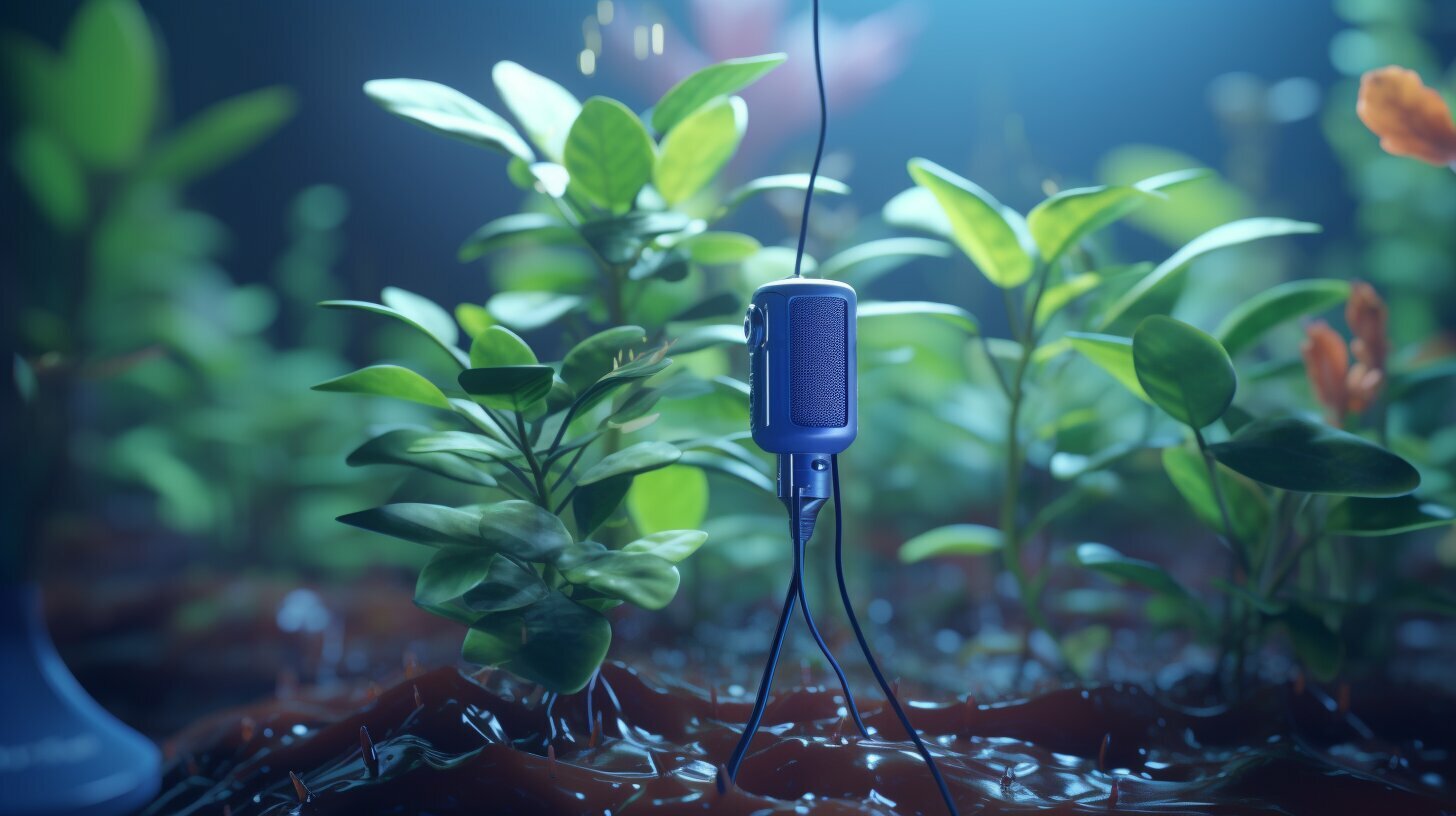Can Plants Hear? I’ve always been fascinated by the mysteries of nature. Recently, I’ve been delving into the intriguing question of whether plants are capable of hearing. Join me on this journey to uncover the latest scientific findings regarding plant communication, perception, and awareness. Let’s explore the sensory systems of plants and unravel the secrets of nature’s communication network.
Key Takeaways:
- Plants possess unique sensory systems that enable them to perceive and respond to their environment.
- The concept of plant communication is essential to understanding whether plants can hear.
- Vibrations play a crucial role in plant communication and may be linked to plant hearing.
- While plants don’t have traditional ears, they possess unique structures that allow them to perceive sound waves.
- Recent scientific studies have shed light on the remarkable level of awareness and intelligence that plants possess.
The Science Behind Plant Communication
Before we can answer the question of whether plants can hear, we must first examine the concept of plant communication. Plants communicate with each other and their environment through various means, including chemical signaling and physical interactions.
One of the ways plants communicate is through releasing volatile organic compounds, such as those found in fragrant flowers or freshly cut grass. These compounds can attract pollinators or repel predators, allowing the plant to thrive.
Plants also have the ability to perceive their environment through their various senses. For example, they can detect changes in light and temperature and adjust their growth and development accordingly. They can even sense the presence of nearby plants and adjust their behavior to compete for resources.
The Science Behind Plant Perception
Plants possess an array of sensory systems that enable them to perceive their surroundings. These include touch, smell, and taste, which help them detect and respond to potential threats or resources.
One fascinating example of plant perception is thigmomorphogenesis, the process by which plants change their growth in response to physical contact. For example, when a plant is touched or exposed to wind, it may grow thicker and stronger to better withstand those conditions.
Through their various communication and sensory systems, plants demonstrate a level of intelligence and awareness that is often underestimated.
The Role of Vibrations in Plant Communication
After exploring the concept of plant communication and perception, we will now dive deeper into the role of vibrations in plant communication. Research has shown that plants may have the ability to sense vibrations and respond to them, suggesting that they may be capable of hearing in some capacity.
Plants use vibrations as a means of communication, both within their own species and with other organisms in their environment. For example, when insects or other animals feed on plants, the plants may release chemicals and emit vibrations that attract predators or parasitoids to defend against the attacker. Similarly, certain plants use vibrations to signal the presence of food or resources to their neighbors, alerting them to potential opportunities.
But how do plants sense vibrations in the first place? One theory is that the tiny hairs on a plant’s leaves and stem may act as sensors, detecting even the slightest movements in the air or ground. Additionally, some plants may use piezoelectricity, a phenomenon in which certain materials produce an electrical charge when subjected to mechanical stress, to sense vibrations.
While the extent to which plants can “hear” is still a subject of debate among scientists, the research into plant communication and perception continues to reveal new insights into the complexity of nature’s communication network. Join me in the next section as we explore whether plants have ears and the surprising ways in which they may perceive sound waves.
Do Plants Have Ears?
When we think of hearing, we often associate it with ears. However, plants don’t have ears in the traditional sense. So, the question remains – do plants have the ability to perceive sound waves?
The answer lies in the unique structures that plants possess. While they don’t have ears, plants have specialized cells that can detect vibrations. These cells, known as mechanoreceptors, are found in various parts of the plant, including the stem, leaves, and root system.
When a sound wave or vibration passes through the plant, it causes the mechanoreceptors to vibrate. This triggers a response in the plant, which can range from a change in growth or movement to the production of chemicals that help the plant defend against predators.
So, while plants may not have ears, they do have a way of perceiving sound and responding to their environment. This is just one aspect of their remarkable sensory system, which allows them to navigate their surroundings and make complex decisions.
Further reading: Can Plants Hear? Exploring the Science of Plant Perception and Awareness.
Unraveling the Secrets of Plant Sensory Systems
Plants possess an incredible array of sensory systems that enable them to perceive and navigate their surroundings. They have touch sensors, which can detect even the slightest touch, enabling them to respond to predators or insects. Plants can also “smell” the air around them, using their olfactory senses to detect chemical signals emitted by other plants or animals. They even have taste sensors, which enable them to distinguish between nutrients and toxins in the soil.
These sensory systems allow plants to make complex decisions about their growth and development. For example, if a plant detects the presence of a predator, it may adjust its growth rate to avoid being eaten. Similarly, if there is a lack of nutrients in the soil, a plant may adjust its root growth to find a more fertile area.
Interestingly, plants also possess a unique sense known as proprioception. This sense allows plants to detect changes in their own shape or form, enabling them to adjust their growth patterns accordingly. This enables them to avoid obstacles and maximize their exposure to sunlight.
Overall, the sensory systems of plants are incredibly sophisticated, underscoring the remarkable level of awareness they possess. Through these sensory mechanisms, plants are able to interact with their environment, respond to stimuli, and make decisions that optimize their growth and survival.
The Latest Findings on Plant Awareness
Recent scientific studies have uncovered fascinating discoveries about plant awareness. It turns out that plants are not the passive organisms we once thought them to be. They possess a remarkable ability to sense and respond to external stimuli, making complex decisions to promote their survival.
One study conducted by researchers at the University of Missouri found that plants have a sophisticated sense of touch that enables them to detect even the slightest vibrations. By using their sensitive root systems, plants can “feel” the movement of nearby organisms and respond accordingly.
Other research has shown that plants can communicate with each other and their surroundings through chemical signals. This process, known as plant communication, allows plants to warn each other of potential threats and coordinate their growth and development.
Perhaps the most surprising discovery is that plants can make decisions based on their environment. For example, if a plant detects a nearby source of water, it will grow its roots in that direction, even if it means sacrificing growth in other areas.
All of these findings point to a level of intelligence and awareness in plants that was once thought to be exclusive to animals. While the question of whether plants can “hear” remains uncertain, we can be certain that they possess an impressive array of sensory systems that contribute to their overall intelligence.
As our understanding of plant awareness continues to evolve, we are gaining a deeper appreciation for the complexity and interconnectedness of the natural world. It is both humbling and awe-inspiring to consider the remarkable abilities of the plants that surround us.
The Conclusion: The Fascinating World of Plant Intelligence
As I conclude this article, we have explored the intriguing question of whether plants can hear and the latest scientific findings regarding plant communication, perception, and awareness. Through this journey, we have uncovered the secrets of nature’s communication network and discovered the sensory systems of plants.
While plants may not have ears like humans or animals, they possess intricate sensory systems that enable them to perceive and respond to their environment. Through their unique communication networks and sensory abilities, plants demonstrate a level of intelligence and awareness that continues to captivate scientists.
The question of whether plants can hear remains a subject of ongoing research, but the evidence suggests that they possess remarkable sensory capabilities. Vibrations play a crucial role in plant communication, and plants may have the ability to sense and respond to them. Although they don’t have ears in the traditional sense, plants possess unique structures that allow them to detect sound waves and “listen” to the world around them.
Understanding the World of Plant Intelligence
Plants possess an array of sensory systems that allow them to navigate and thrive in their surroundings. Their ability to perceive and respond to stimuli demonstrates a remarkable level of awareness. Recent scientific studies have shed light on the complex decisions that plants make and the surprising ways in which they adapt to their environment.
From their communication networks to their sensory systems, plants demonstrate a level of intelligence that continues to amaze and inspire researchers. The wonders of nature’s communication network and the intricate world of plant intelligence hold endless fascination.
So, can plants hear? While we may not have a definitive answer yet, what is clear is the remarkable sensory capabilities of plants and their ability to communicate and thrive in their environment. Join me in marveling at the wonders of nature and the intricate world of plant intelligence.
FAQ
Q: Can plants hear?
A: While plants do not have ears like humans or animals, they possess unique sensory systems that enable them to perceive and respond to their environment.
Q: How do plants communicate?
A: Plants communicate through various means, including chemical signals, electrical impulses, and even vibrations. They use these methods to interact with other plants and their surroundings.
Q: Do plants have any senses?
A: Yes, plants have several senses, including touch, smell, and taste. These senses allow them to sense their environment and respond accordingly.
Q: Are plants aware of their surroundings?
A: Yes, plants possess a level of awareness that enables them to detect changes in their environment and make responses to ensure their survival.
Q: Can plants detect sound waves?
A: While plants do not have ears to detect sound waves, there is research suggesting that they can sense vibrations and respond to them.
Q: How do plants navigate their surroundings?
A: Plants navigate their surroundings through their sensory systems, which allow them to perceive and respond to stimuli such as light, gravity, and touch.
Q: What is the latest research on plant awareness?
A: Recent studies have revealed fascinating insights into the level of awareness that plants possess. They can respond to stimuli and make complex decisions, showcasing a remarkable level of intelligence.





Pingback: Know What Plants are Poisonous to Cats: A Complete Guide - Botanic Plant Life